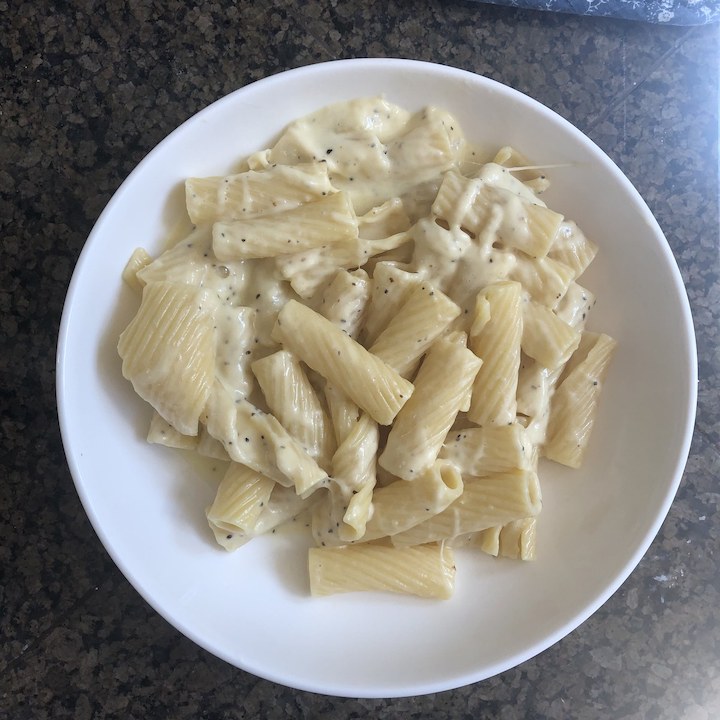I keep telling myself I’ll eat a salad sometime. “This is just temporary,” I say. “I can’t eat nothing but carbs forever.”
It turns out I can.
Anyway, I haven’t cooked any real food this week except pasta, so…here you go.
Egg Yolk Pasta
Ingredients:
- Egg yolk(s)
- Olive oil
- Parmesan or other hard Italian cheese
- Lemon juice/zest (optional)
- Diced garlic (optional)
I discovered this recipe while trying to develop a vegetarian carbonara for myself. I’m vegetarian, by the way. It turns out this technique for making a creamy, emulsified sauce works for just about anything, and I’ve been using it nonstop for weeks now.
Start by boiling your pasta of choice according to package directions. We’re not going to cook it in the sauce, so you really want to make sure it’s cooked all the way through before you drain it. You can use any type of pasta for this, but I would recommend a large, hollow pasta like rigatoni or a bulky noodle like bucatini. Don’t use flat, smooth pastas like fettuccine—the sauce will fly everywhere and get all over your face and your clothes. Not fun.
In a mixing bowl, crack an egg yolk, discarding the whites. You can use these something else, like a meringue or egg white omelette. I usually use 1 yolk per serving, but you can go yolkier (?) if you want. Slowly drizzle in about a ¼ cup of olive oil—I didn’t say this was healthy—and whisk it with the yolk until you get something about the consistency of soft mayonnaise. Then, add your grated parmesan, pepper and lemon/garlic. I really don’t care how much of these you use. Honestly, I’ve gone through a half block of parmesan in one meal before, so I’m not one to judge.
When your pasta is done boiling, spoon a few tablespoons of the pasta water into your sauce bowl, stirring until incorporated. The starch in the water is what will hold your sauce together, making it creamy instead of oily. Once that’s mixed, put your pasta in the bowl and stir it together until the sauce is fully mixed and clings to the pasta. Bon appétit.
Pasta With Easy Tomato Sauce
Ingredients:
- Canned tomato
- Tomato paste (optional but encouraged)
- Onion
- Garlic
- Oregano
- Alcohol if able—preferably white wine or vodka
Dice one onion relatively fine. Sauté it in a wide skillet until it becomes translucent, or until it gets some brown spots. If you have a can of tomato paste, add that here. Deglaze your onions with either water or alcohol—vodka will give you a cleaner flavor, while white wine will make the sauce slightly sweet and fruity. Add your whole can of tomatoes, garlic and oregano, and simmer until noticeably reduced and it sticks to the back of a spoon.
This is the simplest tomato sauce I can think of. If you cook it in a wide frying pan instead of a pot, the increased surface area will let it cook in less than 30 minutes. This sauce will give you everything you want out of a slow-simmered tomato sauce with a fraction of the time and effort.
Super Simple Stovetop Macaroni & Cheese
Ingredients:
- Milk
- Cheese
- Spices
I’ve tried a lot of mac & cheese recipes. I’ve tried them with a flour roux. I’ve tried them with evaporated milk; I’ve even tried them with fancy stabilizers to try to make the “creamiest” sauce possible. Turns out: you don’t need any of those. All you need to make a great mac and cheese is milk, hand-grated cheese and some decent spices.
Boil your pasta according to box directions for al dente. You can use the classic elbow here, or you could use rigatoni or even orecchiette (ear-shaped shells). In a bowl, grate any mix of cheese you’d like. I recommend some mix of sharp cheese, like sharp cheddar, and mild, creamy cheese like gouda or swiss. The most important thing: grate your own cheese! Yes, I know it sucks, but pre-grated cheese from the store is filled with starches and anti-caking agents that impede even melting later on.
Once your cheese is grated, add enough milk to just cover it. Then, add your spices. You can go for the classic black pepper, or you can get adventurous with some paprika, or dried mustard seed. Go nuts. Any spice that you think works with cheese will probably taste good.
When your pasta is cooked, reserve some of the pasta water and drain the rest. Add your pasta back into the pot, along with your cheese mixture and reserved pasta water. Stir it vigorously, mixing continuously until the sauce is fully melted and creamy. That’s it! No sodium citrate, no roux, no evaporated milk. Just cheese and milk, held together by the starch in your pasta water.
